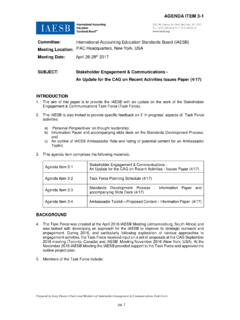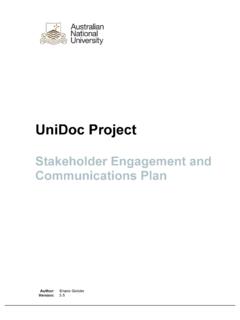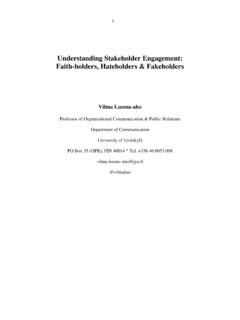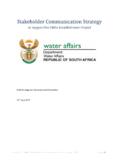Transcription of COMMUNICATION AND STAKEHOLDER ENGAGEMENT …
1 EgyptDR CongoBurundiEthiopiaKenyaRwandaS. SudanSudanTanzaniaUgandaCOMMUNICATION AND STAKEHOLDER ENGAGEMENT STRATEGY2013-2016 NBI COMMUNICATION and STAKEHOLDER ENGAGEMENT strategy [i] AcknowledgementsThe following persons contributed to the preparation of the 2013 - 2016 COMMUNICATION and STAKEHOLDER ENGAGEMENT StrategyDrafting TeamDr. Wubalem Fekade, ENTROMs. Jane Baitwa, Nile-SECMs. Emerita Mugorewicyeza, Nile-SECMr. Warren Nyamugasira, ConsultantContributorsMs. Dorothy Kaggwa, Nile-SEC Dr. Abdulkarim Seid, Nile-SEC Dr. Mohsen Alarabawy, Nile-SECMr. Tom Waako, Nile-SECMs. Juliet Nakassaga, Nile-SEC Ms. Beatrice Adongakulu, Nile-SEC Mr. Peter Kanyi Maina, NELSAP-CUMs. Mwikali Wambua, NELSAP-CUMr. William Katete, NELSAP-Rusumo ProjectDr. Salah Shazali, ENTROMr.
2 Tumwebaze Wycliffe, Ministry of Water-Uganda Mr. Willy Mugenzi, GWP Eastern Africa Mr. Steffen Schw rer, GIZNBI COMMUNICATION and STAKEHOLDER ENGAGEMENT strategy [ii] Table of Contents1. Introduction 12. Background and Context 13. NBI COMMUNICATION and STAKEHOLDER ENGAGEMENT : A Brief Review 24. NBI 2012-2016 Strategic Plan: Providing a framework for the COMMUNICATION and STAKEHOLDER ENGAGEMENT strategy 35. This (2013-2016) NBI COMMUNICATION and STAKEHOLDER ENGAGEMENT strategy 36. NBI COMMUNICATION and STAKEHOLDER ENGAGEMENT : Problems and Challenges 57. Defining Communications 68. Principles Guiding COMMUNICATION and STAKEHOLDER ENGAGEMENT 99. Managing COMMUNICATION in a Crisis Situation 910. Defining STAKEHOLDER ENGAGEMENT 1011. Implementation Planning of the COMMUNICATION and STAKEHOLDER ENGAGEMENT strategy 1212.
3 Limitations 1413. Appendices 14 NBI COMMUNICATION and STAKEHOLDER ENGAGEMENT strategy [1]1. INTRODUCTIONThis NBI 2013-2016 COMMUNICATION and STAKEHOLDER ENGAGEMENT strategy is companion to the NBI Strategic Plan for the period 2012 - 2016. Serious effort has been made to ensure that the strategy is logically consistent and coherent with the NBI Strategic Plan. This strategy will from the vantage of conducting effective COMMUNICATION and STAKEHOLDER ENGAGEMENT activities, be one of the tools to realize the goal and objectives of the NBI 2012-2016 Strategic strategy has been prepared in a consultative way, where all three NBI centers were represented and took part (see Appendix 4). This strategy , while providing an NBI wide overarching framework and guideline, nevertheless is not a one-size fits all document.
4 The document enunciates shared principles and approaches to be adhered to, while permitting each Centre (Nile-SEC, ENTRO and NELSAP-CU) to implement it in a way that is more adaptive to Centre specific demands and BACKGROUND AND CONTEXTThe Nile Basin Initiative (NBI) is a transitional, 10-country, intergovernmental partnership institution established in February 1999. The partnership is guided by a Shared Vision: To achieve sustainable socioeconomic development through equitable utilization of, and benefit from, the common Nile Basin Water resources . NBI Member States are: Burundi, DR Congo, Egypt, Ethiopia, Kenya, Rwanda, South Sudan, The Sudan, Tanzania, and is governed by a Council of 10 Ministers (Nile-COM) in charge of Water Affairs in Member States, which is the highest decision and policy-making body.
5 Nile-COM meets at least once a year and is supported by a Technical Advisory Committee (Nile-TAC), of 20 senior government officials from the partner states. Nile-TAC meets at least twice a is managed from three centers - a basin-wide Secretariat, the Nile Basin Initiative Secretariat (Nile-SEC) located in Entebbe, Uganda responsible for overall corporate direction. The Eastern Nile Technical Regional Office (ENTRO) in Addis Ababa, Ethiopia executes the Eastern Nile Subsidiary Action Program (ENSAP)- comprising Egypt, Ethiopia, South Sudan and Sudan. The Nile Equatorial Lakes Subsidiary Action Program Coordination Unit (NELSAP-CU) based in Kigali, Rwanda executes the Nile Equatorial Lakes Subsidiary Action Program (NELSAP)- comprising Burundi, Democratic Republic of Congo, Egypt, Ethiopia, Kenya, Rwanda, South Sudan, Sudan, Tanzania and Uganda.
6 In each member country there is an NBI office, the Focal Point, which coordinates and links transboundary NBI and national plans and activities. With the above structure in place, soon after it was formed in February 1999, the NBI launched its first basin-wide cooperative water resources Strategic Action Program consisting of: The Shared Vision Program (SVP)- a number of [soft] capacity and confidence building projects [canvassing water resources planning and management, power trade, environment, applied training, confidence building and STAKEHOLDER involvement, agriculture water, socioeconomic development] spread across the Basin to lay the foundation for basin-wide cooperation and build capacity for integrated water resources management all in a trans-boundary context.
7 Two Subsidiary Action Programs (SAPs) aimed at delivering concrete investments/benefits on the ground in the Eastern Nile and the Nile Equatorial Lakes programs have delivered significant results to-date. The SVP has built hitherto unavailable water resources related basin-wide data, information and knowledge as well as regional and national capabilities and systems. The SAPs have identified and prepared cooperative investment projects worth NBI COMMUNICATION and STAKEHOLDER ENGAGEMENT strategy [2]over USD 1 December 2008, NBI has been implementing a four-year (2008 - 2012) Institutional Strengthening Project (ISP), designed to strengthen NBI in readiness for the ultimate transition to the intended Nile River Basin Commission (NRBC) under the Cooperative Framework Agreement (CFA).
8 The ISP enabled NBI to achieve a sound institutional foundation to deliver its core functions of facilitating basin wide cooperation, managing the water resources of the Nile in a sustainable manner and promoting water resources a separate and parallel track distinct from the Strategic Action Program- the cooperation track - The Nile-cOM has been facilitating negotiation over a Cooperative Framework Agreement (CFA) - the negotiation track - among NBI Member States in a bid to enable creation of a permanent institution, the River Nile Basin Commission, to replace the current transitional arrangements under the foregoing developments have had significant impact on NBI s COMMUNICATION and STAKEHOLDER ENGAGEMENT efforts - and constitute the COMMUNICATION Problematique.
9 On the one hand, the achievements of the SVPs and SAPs provide opportunity to highlight NBI s success stories and achievements - and thus its relevance to the wellbeing of both the Nile and its basin wide inhabitants. On the other hand, keeping the negotiation and cooperation track separate have proved increasingly difficult, particularly since June 2010 after the CFA was concluded among six upstream countries. The latter development - the disagreements over the CFA - proved more attention and headline grabbing and overshadowed conversation among the media and stakeholders about the former discussion about managing and developing the common Nile Basin water resources cooperatively and sustainably and success stories. This COMMUNICATION - STAKEHOLDER ENGAGEMENT challenge is expected to persist into the 2012-2016 strategic planning NBI COMMUNICATION AND STAKEHOLDER ENGAGEMENT : A BRIEF REVIEWE ngaging stakeholders, keeping stakeholders informed and facilitating ENGAGEMENT through robust COMMUNICATION and participation has been given due emphasis as one of the building blocks of NBI from the very first days.
10 An entire SVP Project, the ex-CBSI (Confidence Building and STAKEHOLDER Involvement), was established to pursue this agenda. Significant achievements have been scored under CBSI in terms of engaging a wide array of stakeholders from across the basin. Various forums have been organized that provided space to stakeholders for dialogue and participation in and thus influence NBI activities and ultimately results. Forums targeting ENGAGEMENT of specific STAKEHOLDER groups such as women, parliamentarians, media, academia, civil society, NBI elders, ex-diplomats and lawyers have been organized. Though regrettably it has not been possible to sustain them. A range of COMMUNICATION products highlighting NBI achievements and advocating NB cooperation have been these efforts resulted in robust support for NBI among stakeholders has been of paramount interest to NBI.









